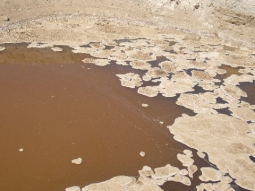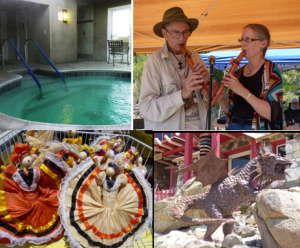
By Miriam Raftery
“This is a recipe for disaster, potentially putting us in harm’s way AND increasing our already high fire insurance policies…This is a project that could generate dangerous chemical fires that when spread, could cause property damage as well as loss of life.”—Danielle Cook , member, Jacumba-Boulevard Revitalization Committee
June 13, 2015 (Jacumba Hot Springs)—A proposed industrial-scale solar facility near Jacumba is sparking heated controversy, with some residents raising concerns over fire danger and impacts on local water supplies, wildlife, traffic and public safety.
NextEra Energy, a division of Florida Power and Light, wants to cover 108 acres of a 304 acre site in the Jacumba area with 81,109 solar photovoltaic modules on 2,253 tilting rack panels—along with a collector substation, transmission lines, and lithium battery energy story systems in containers the size of cargo cars. Ultimately, the project would produce up to 20 megawatts of power, according to a draft environmental impact report prepared by the consulting firm DUDEK.
Proponents contend the project is needed to help meet the state’s ambitious renewable energy goals to reduce greenhouse gas emissions, a key component in combatting climate change.
But Danielle Cook, ,member of the Jacumba-Boulevard Revitalization Alliance, has raised serious objections to this project, which she believes threatens the region’s ecosystem and its burgeoning efforts to increase tourism, also posing a huge fire danger.
She cites a peer-reviewed scientific report published by the Sierra Club in BioScience which states, “...large-scale solar energy development as an `environmentally friendly’ alternative to conventional energy sources may actually increase environmental degradation on a local and regional scale.”
Cook supports green energy and has solar panels on her own home, but wants large-scale solar in urban areas on already-impacted or contaminated land. She summarizes her objections to the project. “We are poisoning our fragile desert ecosystem, exposing our community to potential carcinogens, greatly increasing our fire danger and handing off our precious groundwater for a billion dollar corporation from Florida who, once they receive their corporate welfare (30% rebate from the government plus other tax benefits) will return to Florida andset their sights on another poor, rural community who can’t easily fight back!”
 Cook, in comments submitted on the draft EIR, notes that there have been virtually no studies on effects of industrial solar projects on desert wildlife and habitats. Moreover, Cook says she could find no information to prove NextEra’s claim that dust suppression chemicals planned for use (Envirotac II or RhinoSnot)are nontoxic.
Cook, in comments submitted on the draft EIR, notes that there have been virtually no studies on effects of industrial solar projects on desert wildlife and habitats. Moreover, Cook says she could find no information to prove NextEra’s claim that dust suppression chemicals planned for use (Envirotac II or RhinoSnot)are nontoxic.
RhinoSnot used in Ocotillo at a wind project created a sludgy foam that flooded streets and residential yards. (photo, right) When it evaporated in the deserst heat, the chemical was also flammable, a toxics official in Imperial Valley told ECM. That would clearly pose a huge danger in Jacumba’s fire-prone area and communities west of Jacumba that would be in the path of any firestorm.
“Neither has been tested concerning their effect on lizards, birds or mammals including humans,” Cook told ECM regarding the chemicals. “They will be spraying this stuff on the property for years.” She recalled Monsanto claims that the pesticide DDT was safe, too, until Rachel Carson’s book Silent Spring proved it was responsible for the near-extinction of eagles, pelicans and other species.
She also objects to the developer’s attempt to position Jacumba Hot Springs as a town in decline.
“Our residents have rallied and worked hard over the past few years to revitalize the town and it is working,” she states. Those efforts including hosting a Centennial celebration and four festivals last year, attracting a buyer for the hot springs spa who invested $100,000 in renovations, raising money to install public art at the park and community center, developing a walking tour of Jacumba and brochure, restoring a lake and other efforts now attracting bi rdwatchers, vintage car clubs, motorcyclists and other tourists who come to enjoy scenic views, breathe our clean air, revel in the quiet of nature, recharge in our hot springs and enjoy dark skies. A new website, www.gosandiegobackcountry.org, has guides to activities from road trips to rockclimbing, stargazing to geo-caching, art destinations and more. (Photo, left, shows recent revitalization projects and festivals in Jacumba Hot Springs.)
rdwatchers, vintage car clubs, motorcyclists and other tourists who come to enjoy scenic views, breathe our clean air, revel in the quiet of nature, recharge in our hot springs and enjoy dark skies. A new website, www.gosandiegobackcountry.org, has guides to activities from road trips to rockclimbing, stargazing to geo-caching, art destinations and more. (Photo, left, shows recent revitalization projects and festivals in Jacumba Hot Springs.)
"An industrial scale solar project has “potential to destroy our tourism economy and jobs,” Cook warns.
Cook says the EIR under-reported the town’s population by 30%, falsely stated no improvements are planned for its airport when funding has been approved, and misleadingly cites traffic patterns in the wrong direction – conveniently omitting the fact that dozens of large trucks would rumble the Jacumba’s downtown – a rural two-lane highway with no traffic lights, where children cross and an elderly resident in a wheelchair was recently killed trying to cross the street.
The developer claims property values will be increased, but in fact there is evidence that large-scale energy projects decrease property values of residential properties nearby. The DUDEK report used old rainfall records from 1982 to June 2012, ignoring recent years of drought, to claim there is enough rain to recharge groundwater slated to be pumped for construction. DUDEK has a history of under-estimating water use, notably at the SDG&E ECO Substation that used three times more water than estimated. The developer has offered to build a new well for the town, a prospect that has drawn interest from some of the local planning group members. But Cook believes that’s not adequate..
The developer claimed Jacumba Solar would have minimal impact on air quality, largely ignoring dust issues and relying on the nearest monitoring station in Alpine – very far away from Jacumba. In Imperial Valley, which has numerous desert solar projects, asthma rates have soared.
The EIR omits mention of sensitive species found in the Jacumba area, such as tri-colored blackbirds and certain species of bats. No survey of rare plants was conducted, either, at the site.
Perhaps the most worrisome fact, however, is that the project is located in an area classified by CalFire as a Very High Fire Severity Zone that is further classified as a “wildfire corridor.” Based on the area’s history and fuels, “a high intensity fire can be expected to occur in the project area” in the future, whether caused by nature or man.
Cook asks, “This is where we want to install 81,000 solar panels, 10 container size lithium battery units, inverters and other potential ignition sources? Are we serious?”
The developer has offered mitigation such as spraying water during construction and listing four fire stations nearby. But Cook calls those claims “smoke and mirrors” noting that only two of the stations (Jacumba and Boulevard) are within the county-mandated 20 minutes response time. A third station is closing down and the fourth is too far away. Moreover, the only foam truck in the area designed to handle electrical fires is “not in working order”, Cook states.
She concludes, “This is a recipe for disaster, potentially putting us in harm’s way AND increasing our already high fire insurance policies…This is a project that could generate dangerous chemical fires that when spread, could cause property damage as well as loss of life.”
Howard Cook, former chair of the Jacumba planning group, has asked that the EIR process be restarted due to violations of notification and agenda requirements.
Danielle Cook has told ECM that some residents report being intimidated by the project’s backers and are afraid to speak out in public forums.
NextEra did not respond to our requeste for comments.
NextEra, it should be noted, has itself engaged in bullying tactics against an anti-wind activist in Canada who videotaped NextEra’s contractor removing a bald eagle nest. After the Activist posted a parody of NextEra’s logo onlined labeled “Next Terror,” the company sued her for copyright infringement.
But the Cooks says they refuse to be silenced. “Like Rachel Carson, we will not give up pointing out the dangers inherent in these types of projects,” Danielle Cook told ECM, “as we love our community and want to protect it.”







Recent comments